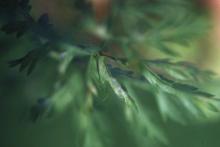Cause Erysiphe heraclei, a fungus. This disease can be found on fall-planted carrots and can overwinter on carrot seed crops. Another host plant is wild carrot. Some varieties, like Nantes and Imperator, appear more susceptible to the disease. Severe infection results in low yields and poor seed quality.
Symptoms The disease affects the foliage, stems, and umbels. Patches of the white felt-like fungus appear on lower leaves first, and then spread to the terminal growth. The fungus often covers entire leaves with its masses of white mycelium and powdery spores. Infected foliage becomes brittle and may eventually turn brown, shrivel, and die. Diseased pedicels may turn brown, resulting in the florets' premature death.
Cultural control
- Isolate new carrot fields from established infected fields.
Chemical control
- Bicarbonates are registered to control powdery mildew. Thorough coverage is essential.
- Bi-Carb Old Fashioned Fungicide at 4 teaspoons/2 gal water on 7- to 10-day intervals. May be applied up to the day before harvest. H O
- Carb-O-Nator at 2.5 to 5 lb/100 gal of water on 5- to 14-day intervals, depending on disease pressure. Preharvest interval is zero (0) days for all listed crops. 4-hr reentry. O
- Kaligreen at 2.5 to 3 lb/A on 7- to 10-day intervals. May be applied up to the day before harvest. 4-hr reentry. O
- MilStop SP at 2 to 5 lb/A on 7- to 14-day intervals. Can be applied up to and including the day of harvest. 1-hr reentry. O
- Vacres at 2.5 to 5 lb/A on 7- to 14-day intervals. Preharvest interval is zero (0) days. 4-hr reentry.
- Demethylation-inhibiting (DMI) Fungicides (Group 3) are labeled for use.
- Cevya at 3 to 5 fl oz/A on minimum interval of 7 days. Preharvest interval is 7 days. 12-hr reentry.
- PropiMax EC at 4 fl oz/A on 7- to 10-day intervals. Do not apply within 14 days of harvest. 12-hr reentry.
- Rally 40WSP at 5 to 7.5 oz/A in Oregon (SLN OR- 240005) and at 5 to 8 oz/A in Washington (SLN WA-230008) on 14- to 21-day intervals for seed crop only. Carrot seed and any other portion of carrot seed plants may not be distributed for human consumption or animal feed. 24-hr reentry.
- Tilt at 2 fl oz/A in a tank-mix with 0.75 lb ai of chlorothalonil on 7- to 10-day intervals. Preharvest interval is 14 days. 12-hr reentry.
- Topaz at 2 fl oz/A plus chlorothalonil on 7- to 10-day intervals. Preharvest interval is 14 days. 12-hr reentry.
- Fontelis (Group 7) at 16 to 30 fl oz/A on 7- to 14-day intervals. Do not make more than two (2) sequential applications before alternating to a labeled fungicide with a different mode of action (non-Group 7). Preharvest interval is 0 days. 12-hr reentry.
- Inspire Super (Group 3 + 9) at 16 to 20 fl oz/A on 7- to 10-day intervals. Make no more than two (2) sequential applications. Preharvest interval is 7 days. 12-hr reentry.
- Merivon Xemium (Group 7 + 11) at 4 to 5.5 fl oz/A on 7- to 14-day intervals. Do not make more than two (2) applications before alternating to a fungicide in different FRAC groups (non-Group 7 and non-Group 11). Preharvest interval is 7 days. 12-hr reentry.
- OSO 5% SC (Group 19) at 3.75 to 13 fl oz/A on 7- to 14-day intervals. Can be applied the day of harvest. 4-hr reentry. O
- Switch 62.5WG (Group 9 and 12) at 11 to 14 oz/A on 7- to 10-day intervals. No more than two (2) sequential applications alternating with another fungicide with a different mode of action (non-Group 9 and 12). Do not allow cattle or other livestock to feed upon leaves of vegetables. Preharvest interval is 7 days. 12-hr reentry.
- Strobilurin fungicides (Group 11) are labeled for use. Do not make more than one (1) application of a Group 11 fungicide before alternating to a labeled fungicide with a different mode of action.
- Cabrio EG at 8 to 12 oz/A on 7- to 14-day intervals. Preharvest interval is 0 days. 12-hr reentry.
- Pristine at 8 to 10.5 oz/A on 7- to 14-day intervals. Preharvest interval is 0 days. 12-hr reentry.
- Quadris Flowable at 9 to 15.5 fl oz/A or Quadris Opti at 2.4 pints/A on 7- to 14-day intervals. May be applied the day of harvest. 4-hr reentry for Quadris Flowable, 12-hr reentry for Quadris Opti.
- Quilt Xcel at 14 fl oz/A on a 7- to 10-day interval. Do not apply within 14 days of harvest. 12-hr reentry.
- Sulfur is registered. Sulfur is fungitoxic in its vapor phase and, therefore, is effective only when air temperatures promote volatilization. Sulfur volatilizes above 65°F but becomes phytotoxic above 95°F. Using it above 85°F is not recommended. Do not apply if temperature will exceed 90°F within 3 days after application. Do not use within 2 weeks of an oil treatment. Although sulfur reduces sporulation of established infections, it is primarily a protectant and must be applied before infection.
- Microthiol Disperss at 3 to 10 lb/A. Do not apply if temperature will exceed 90°F within 3 days after application. Do not allow spray drift to sensitive plants (spinach, etc.). Do not use within 2 weeks of an oil treatment. 24-hr reentry. O
- Thiolux at 3 to 10 pounds/A. 24-hr reentry.
Biological control
- Ecoswing at 1.5 to 2 pints/A. Preharvest interval is 0 days. 4-hr reentry. O
- Sonata at 2 to 4 quarts/A on 7- to 14-day intervals for disease suppression. Can be applied up to and on the day of harvest. 4-hr reentry. O
References Dillard, H.R., and Cobb, A.C. 1992. Powdery mildew of carrot in New York. Plant Dis. 76:972.
Glawe, D.A., Pelter, G.Q., and du Toit, L.J. 2005. First report of powdery mildew of carrot and parsley caused by Erysiphe heraclei in Washington state. Plant Health Progress doi:10.1094/PHP-2005-0114-01-HN.


